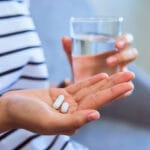Many popular drinks include colorings (think punches, sodas, and some spirits), tannins (think tea), acids (lemon sparkling water, juices, and sodas again), all of these creating their characteristic appealing shades. These added components can stain the surface of your teeth in just a short period of time of regular enjoyment.
If you want to limit the effect on your white teeth, use a straw! Inserted into a lid or sticking out the top of the cup, a straw acts as a transport tube, bringing the drink past your lips and teeth and straight to your tongue, where your taste buds register the flavors and textures. With a straw, you reduce the contact with your teeth, and prevent them from changing color from white to yellow (or even darker shades). Plastic straws are increasingly disapproved by some, especially environmentalists. But before we discuss that, let’s cover a bit of history about the straw.
Early Beginnings of Straws
Around 3,000 B.C.E. the Sumerians of Mesopotamia fermented their versions of beer in large vats. The vats were too heavy to move frequently, and they didn’t have bottling or canning options. They needed a way to get their beer while it was still in the vat. Archaeologists discovered straws made from gold and other materials to bring that brew to thirsty mouths. They believe earlier versions were made from wood or natural hollow plants. People in Argentina also used straws thousands of years ago.
In the 1800s, many individuals used straws made from rye grass to drink their beverages. Unfortunately, they left an earthy aftertaste, and the straws didn’t last long — eventually they turned into mush. Around 1888, Marvin Stone wrapped manilla paper around a pencil, sealed it with glue, and used that in place of the rye. This was the first rendition of the modern drinking straw. In 1937, Joseph Friedman looked at straws from a different angle, adding a flexible bend to the upper portion of the tube. These “bendy straws” became very popular, especially for children.
After World War II ended, plastic manufacturers needed a different niche for their product. They found that niche in creating “disposable” drinking straws. Although plastic straws could be reused, world cultures caught on to just throwing them away after a single use.
The Impact of the Plastic Straw
Unfortunately, plastic straws are nonbiodegradable. Millions are used every day in the United States alone — and that’s been going on for decades. Due to their small, thin profile, straws escape containment very easily. It’s estimated that straws are one of the top 5 contributors to plastic marine waste. A 5-year cleanup of American shorelines collected nearly 7.5 million plastic straws.
In August 2015, marine biologist Christine Figgener posted a video of removing a plastic straw stuck in a turtle’s nostril. The video went viral. Eventually, countries like France and England imposed bans on providing plastic straws and similar items. In 2019, the Governor of California enacted a “straw upon request” policy. Due to these restrictions, straws made from other materials are becoming more popular. Many companies have reintroduced the paper straw for their customers, with mixed approval. Another alternative is purchasing a personal, reusable set of straws made of metal, like stainless steel. This removes any plastic aftertaste, and even keeps your chosen drink cool on the way to your palate.
Straws from the Dental Perspective
The Yuba City Dentistry Group has a great appreciation for the straw. If you are indulging in a sugary drink, a highly colored one, or an acidic beverage, a straw greatly reduces how much of those damaging components meet with your teeth. We also understand that there might be times when a plastic straw is still the best option — for instance, in avoiding allergic reactions, or investing in a survival straw for a bugout bag. Whatever kind you choose, straws help to protect your teeth, and that is our main concern.
If you feel that you haven’t been using straws enough and your teeth are not as white as they could be, the Yuba City Dentistry Group offers tooth whitening treatments. Please give us a call to discuss any concerns you might have about the status of your teeth. We are available over the phone, or you can schedule an appointment online.




0 Comments